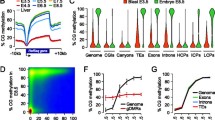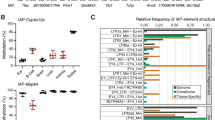Abstract
In mammals, CpG methylation is one of the mechanisms of epigenetic control over the linear sequence of bases of deoxyribonucleic acid (DNA); about 70% of CpG dinucleotides are methylated. The actual signal that triggers DNA methylation is not known, although repetitive DNA has been shown to be an attractive template for DNA methylases. To address methylation events associated with transgenic copy number, we have analyzed transgenes that are actively transcribed in a tissue-specific manner. We have compared gross transgene methylation by restriction-enzyme digestion in expressing and nonexpressing tissues. The observed pattern suggests that the DNA methylation machinery can recognize repeated genomic sequences independently of their transcriptional activity.
Similar content being viewed by others
References
Garrick D., Fiering, S., Martin, D. I., and Whitelaw, E. (1998) Repeat-induced gene silencing in mammals. Nat. Genet. 18, 56–59.
Bird, A. (2002) DNA methylation patterns and epigenetic memory. Genes Dev. 16, 6–21.
Walsh, C. P. and Bestor, T. H. (1999) Cytosine methylation and mammalian development. Genes Dev. 13, 26–34.
Whitelaw, E. and Martin, D. I. (2001) Retrotransposons as epigenetic mediators of phenotypic variation in mammals. Nat Genet. 27, 361–365.
Ramirez, A., Milot, E., Ponsa, I., et al. (2001) Sequence and chromosomal context effects on variegated expression of keratin 5/lacZ constructs in stratified epithelia of transgenic mice. Genetics 158, 341–350.
Whitelaw, C. B. A., Harris, S., McClenaghan, M., Simons, J. P., and Clark, A. J. (1992) Position-independent expression of the ovine beta-lactoglobulin gene in transgenic mice, Biochem. J. 286, 31–39.
Burdon, T. G., Maitland, K. A., Clark A. J., Wallace, R., and Watson, C. J. (1994) Regulation of the sheep beta-lactoglobulin gene by lactogenic hormones is mediated by a transcription factor that binds an interferon-gamma activation site-related element. Mol. Endocrinol. 8, 1528–1536.
Whitelaw, C. B. A., Grolli, S., Accornero, P., Donofrio, G., Farini, E., and Webster, J. (2000) Matrix attachment region regulates basal beta-lactoglobulin transgene expression. Gene 244, 73–80.
Dorer, D. R. and Henikoff, S. (1994) Expansions of transgene repeats cause heterochromatin formation and gene silencing in Drosophila. Cell 77, 993–1002.
Dobie, K. W., Lee, M., Fantes, J. A., Graham, E., Clark, A. J., and McClenaghan, M. (1996) Variegated transgene expression in mouse mammary gland is determined by the transgene integration locus. Proc. Natl. Acad. Sci. USA 93, 6659–6664.
Michelotti, E. F., Sanford, S., and Levins, D. (1997) Marking of active genes on mitotic chromosomes. Nature 388, 895–899.
Jenuwein, T., Forrester, W. C., Fernandez-Herrero, L. A., Laible, G., Dull, M., and Grosschedl, R. (1997) Extension of chromatin accessibility by nuclear matrix attachment regions. Nature 385, 269–272.
Chevalier-Mariette, C., Henry, I., Mountford, L., et al. (2003) CpG content affects gene silencing in mice: evidence from novel transgenes. Genome Biol. 4, R52 (epub).
Sutherland, H. G., Kearns, M., Morgan, H. D., et al. (2000) Reactivation of heritably silenced gene expression in mice. Mamm. Genome 11, 347–355.
Robertson, G., Garrick, D., Wilson, M., Martin, D. I., and Whitelaw, E. (1996) Age-dependent silencing of globin transgenes in the mouse. Nucl. Acids Res. 24, 1465–1471.
Opsahl, M. L., McClenaghan, M., Springbett, A., et al. (2002) Multiple effects of genetic background on variegated transgene expression in mice. Genetics 160, 1107–1112.
Valenza-Schaerly, P., Pickard, B., Walter, J., et al. (2001) A dominant modifier of transgene methylation is mapped by QTL analysis to mouse chromosome 13. Genome Res. 11, 382–388.
Author information
Authors and Affiliations
Corresponding author
Rights and permissions
About this article
Cite this article
Pena, R.N., Webster, J., Kwan, S. et al. Transgene methylation in mice reflects copy number but not expression level. Mol Biotechnol 26, 215–219 (2004). https://doi.org/10.1385/MB:26:3:215
Issue Date:
DOI: https://doi.org/10.1385/MB:26:3:215




